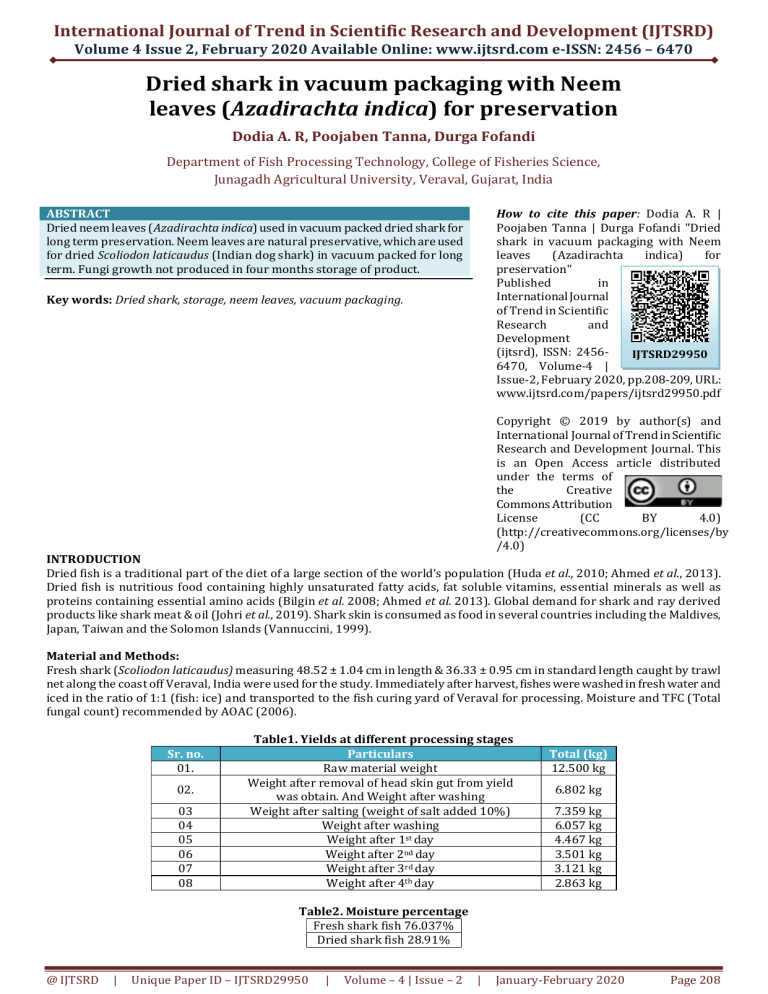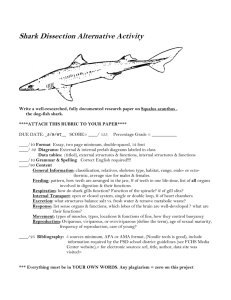
International Journal of Trend in Scientific Research and Development (IJTSRD)
Volume 4 Issue 2, February 2020 Available Online: www.ijtsrd.com e-ISSN: 2456 – 6470
Dried shark in vacuum packaging with Neem
leaves (Azadirachta indica) for preservation
Dodia A. R, Poojaben Tanna, Durga Fofandi
Department of Fish Processing Technology, College of Fisheries Science,
Junagadh Agricultural University, Veraval, Gujarat, India
ABSTRACT
Dried neem leaves (Azadirachta indica) used in vacuum packed dried shark for
long term preservation. Neem leaves are natural preservative, which are used
for dried Scoliodon laticaudus (Indian dog shark) in vacuum packed for long
term. Fungi growth not produced in four months storage of product.
How to cite this paper: Dodia A. R |
Poojaben Tanna | Durga Fofandi "Dried
shark in vacuum packaging with Neem
leaves
(Azadirachta
indica)
for
preservation"
Published
in
International Journal
of Trend in Scientific
Research
and
Development
(ijtsrd), ISSN: 2456IJTSRD29950
6470, Volume-4 |
Issue-2, February 2020, pp.208-209, URL:
www.ijtsrd.com/papers/ijtsrd29950.pdf
Key words: Dried shark, storage, neem leaves, vacuum packaging.
Copyright © 2019 by author(s) and
International Journal of Trend in Scientific
Research and Development Journal. This
is an Open Access article distributed
under the terms of
the
Creative
Commons Attribution
License
(CC
BY
4.0)
(http://creativecommons.org/licenses/by
/4.0)
INTRODUCTION
Dried fish is a traditional part of the diet of a large section of the world’s population (Huda et al., 2010; Ahmed et al., 2013).
Dried fish is nutritious food containing highly unsaturated fatty acids, fat soluble vitamins, essential minerals as well as
proteins containing essential amino acids (Bilgin et al. 2008; Ahmed et al. 2013). Global demand for shark and ray derived
products like shark meat & oil (Johri et al., 2019). Shark skin is consumed as food in several countries including the Maldives,
Japan, Taiwan and the Solomon Islands (Vannuccini, 1999).
Material and Methods:
Fresh shark (Scoliodon laticaudus) measuring 48.52 ± 1.04 cm in length & 36.33 ± 0.95 cm in standard length caught by trawl
net along the coast off Veraval, India were used for the study. Immediately after harvest, fishes were washed in fresh water and
iced in the ratio of 1:1 (fish: ice) and transported to the fish curing yard of Veraval for processing. Moisture and TFC (Total
fungal count) recommended by AOAC (2006).
Sr. no.
01.
02.
03
04
05
06
07
08
Table1. Yields at different processing stages
Particulars
Raw material weight
Weight after removal of head skin gut from yield
was obtain. And Weight after washing
Weight after salting (weight of salt added 10%)
Weight after washing
Weight after 1st day
Weight after 2nd day
Weight after 3rd day
Weight after 4th day
Total (kg)
12.500 kg
6.802 kg
7.359 kg
6.057 kg
4.467 kg
3.501 kg
3.121 kg
2.863 kg
Table2. Moisture percentage
Fresh shark fish 76.037%
Dried shark fish 28.91%
@ IJTSRD
|
Unique Paper ID – IJTSRD29950
|
Volume – 4 | Issue – 2
|
January-February 2020
Page 208
International Journal of Trend in Scientific Research and Development (IJTSRD) @ www.ijtsrd.com eISSN: 2456-6470
The neem leaves was a bitter tonic herb that reduces inflammation and clears toxins, while promoting healing and improving
all body functions of human. Apart from this, it has parasitic, insecticidal spermicidal properties and hence destroys a wide
range of organisms (Dixit et al., 1986). Razzaghi-Abyaneh et al. (2005) reported that extracts of plants such as neem have been
found to effectively inhibit the growth of fungi. Ipinmoroti and Taiwo (2015) explained that the effectiveness of neem leaves
(Azadirachta indica) in slow down fungi growth on smoked dried C. nigrodigitatus.
Observation:
Dried shark packed in vacuum packaging with dried neem leaves remain good quality after 4 months of storage. No white spot
or fungi found in storage sample. No TFC (Total fungal count) found in dried shark product in vacuum packaging.
Conclusion:
The results from the present study suggests that
traditionally dried shark ((Scoliodon laticaudus)) performed
well in terms of quality and safety as stored products when
packed with dried neem leaves in vacuum packaging. It was
observed that the vacuum packaging with neem leaves may
assure an effective packaging for dried fish quality for long
term storage.
References
[1] AOAC. 2006. Official Methods of Analysis of the
Association of Official Analytical Chemists (AOAC)
International 18th edition.
[2] Huda, N.; Dewi, R. and Ahmad, R. 2010. Traditional
smoked catfish, effects on amino acid profile. Journal of
Fisheries and Aquaculture Science, 5(2):106–112.
[3] Ahmed, E. O.; Adm, H. T. and Mohammed, K. E. 2013.
Investigating the Quality Changes of Hot Smoked
Clarias lazera at Refrigerated Temperature (5 ± 1 ° C).
Journal of Agriculture and Food Science, 1(3):27–32.
[4] Bilgin, S.; Ünlüsayın, M.; İzci, L. and Günlü, A. 2008. The
Determination of the Shelf Life and Some Nutritional
Components of Gilthead Seabream (Sparus aurata L.,
1758) after Cold and Hot Smoking. Turk. J. Vet. Anim.
Science, 32(1): 49–56.
@ IJTSRD
|
Unique Paper ID – IJTSRD29950
|
[5] Dixit, V. P.; Sinha, R. and Tank, R. 1986. Effect of neem
seed oil on the blood glucose concentration of normal
and alloxan diabetic rates. J. Ethnopharmacol., 17: 9598.
[6] Ipinmoroti, M. O and Taiwo, I. O. (2015). Growth
response of microorganism to powdered neem leaves
(Azadirachta indica) and vegetable oil on smoked dried
fillets of African Catfish (Chrysichthys nigrodigitatus).
International Journal of Fisheries and Aquatic Studies,
2(5): 133-136
[7] Johri S, Solanki J, Cantu V, Fellows S, Edwards R,
Moreno I, Vyas A and Dinsdale E (2019) ‘Genome
skimming’ with the MinION hand-held sequencer
identifes CITES-listed shark species in India’s exports
market. Scientific reports, 9(2019):4476.
[8] Razzaghi-Abyaneh M, Allameh A, Tiraihi T, Shams
Ghahfarokhi M, Ghorbanian M. (2005). Morphological
alterations in toxigenic Aspergillus parasiticus exposed
to neem (Azadirachta indica) leaf and seed aqueous
extracts. Mycopathologia, 159:565-570.
[9] Vannuccini, S. 1999. Shark utilization, marketing and
trade. FAO Fisheries Technical Paper No. 389. FAO.
Rome. 470 pp.
Volume – 4 | Issue – 2
|
January-February 2020
Page 209


